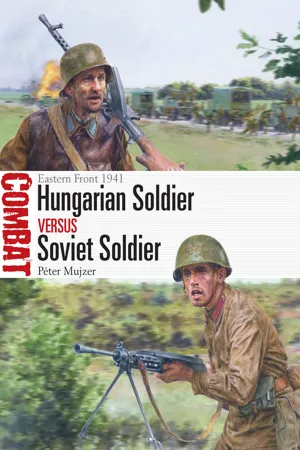
- 80 pages
- English
- PDF
- Available on iOS & Android
About This Book
On 26 June 1941, unidentified bombers attacked the Hungarian town of Kassa, prompting Hungary to join its Axis partners in Operation Barbarossa, Hitler's invasion of the Soviet Union. Hungary's contribution to Barbarossa was designated the Carpathian Group, its most powerful component being the Mobile Corps, which fielded motorized rifle, cavalry, bicycle and light armoured troops. The Hungarians faced Soviet forces belonging to the Kiev Military District, deployed in four armies along a 940km-long front. On the defeated side in World War I, Hungary had seen its borders redrawn and its armed forces constrained by treaty, but was determined to recover territories lost to adjoining countries. When Hungary decided to participate in Operation Barbarossa, however, the Royal Hungarian Army was deployed in the Soviet Union and not against its neighbours. Meanwhile, the Red Army, while remaining among the most formidable armies of the era, had been seriously weakened by successive purges, its shortcomings exposed by the Winter War against Finland in 1939–40. During the opening battles (4–13 July), the Hungarian motorized rifle and armoured units clashed with the withdrawing Red Army forces. In the battle for Uman (15 July–8 August) the Hungarians blocked the Soviet troops' efforts to break out from encirclement. During the Hungarian defensive operation at the River Dniepr (30 August–6 October), counter-attacking Soviet units exerted heavy pressure on the defending Hungarians. Both sides would seek to draw lessons from these opening battles as the war in the East continued to rage into 1942. Fully illustrated, this book investigates the Hungarian and Soviet soldiers who fought in three battles of the Barbarossa campaign, casting new light on the role played by the forces of Nazi Germany's allies on the Eastern Front.
Frequently asked questions
Information
Table of contents
- Cover
- Contents
- Introduction
- The Opposing Sides
- Opening Battles
- Golovanevsk
- Khortytsia
- Analysis
- Aftermath
- Unit Organizations
- Bibliography
- Index
- Imprint